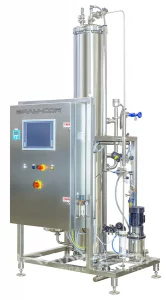METHODS OF PRODUCING WATER FOR INJECTION
TWO MAIN METHODS TO PRODUCE WATER FOR INJECTION
The safe way: the change of state
As agreed in the main pharmacopoeias, Water for Injection can be produced through Vapor Compression or Multiple Effect distillation or through Reverse Osmosis system with a downstream unit of ultrafiltration. Within these several methods for producing Water for Injection (WFI), we consider distillation-based methods, which involve a change of state, to be safer.
Multiple Effect (MED) and Vapor Compression (VCD) Distillation are also the two primary methods recognized by the FDA and Ph.Eur. Both are established methods, offering different advantages depending on the proposed application. BRAM-COR employs these two different technologies in some versions and with many water pretreatment options to obtain compendial WFI, the worldwide standard for pharmaceutical applications, I.V. fluids and parenteral solutions.

WFI generation via Vapor Compression Still
VC distillation system is also known as thermocompression / vapor recompression or thermal / mechanical vapor compression. It is a technology similar to the evaporation systems used for the water desalination (vapor compression is also a common term in the refrigeration industry).
Furthermore, the VC distillation system can be powered by either steam or electric heating, and has minimal feed water quality requirement due to lower operating temperature.
WFI generation via Multiple Effect Distiller
Multiple-effect stills (ME System) are mainly characterized by their multiple column design which reuses steam energy through the process, requiring minimal moving parts, but requiring cooling water for final distillation of product.
In case of low required capacities (since MED systems absorbing much energy and cooling water) you can also get WFI from Single Effect Distiller (BRAM-COR Mod. DPSG), that is both a Still and a Pure Steam Generator.
Membrane-based WFI via Ultrafiltration (UF)
As we have stated before, we do not believe that Reverse Osmosis system is the safest method to produce Water for Injection (WFI), unless the feed water is truly excellent. Above all, with the availability of more technologically advanced membranes, we can theoretically produce “cold” WFI by adding an Ultrafiltration unit downstream (pre-treatment techniques, such as water softening, descaling, pre filtration, degasification, nanofiltration, electro-deionisation, ozonation, UV treatment and micro-filtration, should all be considered, in relation to the feed water quality). This enable us to produce cold WFI that meets all the parameters required (USP, Ph. Eur., JP, …).
Therefore, Bram-Cor has no problem in designing a turnkey plant for the production of WFI from reverse osmosis. However, once in production, the RO system requires -unlike distillers- a continuous control on its efficiency, in terms of membrane degradation, biofilm prevention and microbial charges, with periodic sanitization and validation. If there are no obstacles in ensuring this constant monitoring, which must also concern distribution loops, the Reverse Osmosis system can offer a real advantage, reducing the energy demand.
You can also read a “Guideline on the quality of water for pharmaceutical use” from EMA (European Medicines Agency) (Site source: https://www.ema.europa.eu/en/homepage)
Water for Injection systems by Vapor Compression distillation
The advantage of a higher efficiency
(low cost by quantity produced in comparison to MED)
BRAM-COR Vapor Compression Distiller Mod. STMC improperly called thermocompressor or thermal recompression still, produces Water for Injection, the reliable compendial distilled water for pharmaceutical applications. As a result, many products benefit from WFI, such as LVP or SVP (Large volume / Small Volume Parenteral), any injectable product as well as washing medias and special solutions where
- quality factors (such as the sterility, elimination of the pyrogens and low molecular weight chlorine solvents)
- economical factors (low running costs)
are critical to the success of the pharmaceutical process.
The STMC distiller can produce either cold or hot distillate with huge savings in energy costs and with no need for cooling water. STMC Vapor Compression Distillers operate with electrical heating (STMC EL) or plant steam heating (STMC ST) or even through both electrical and steam heating systems (STMC ES). Capacities range: from 20 to 20.000 lph with one/more blowers.
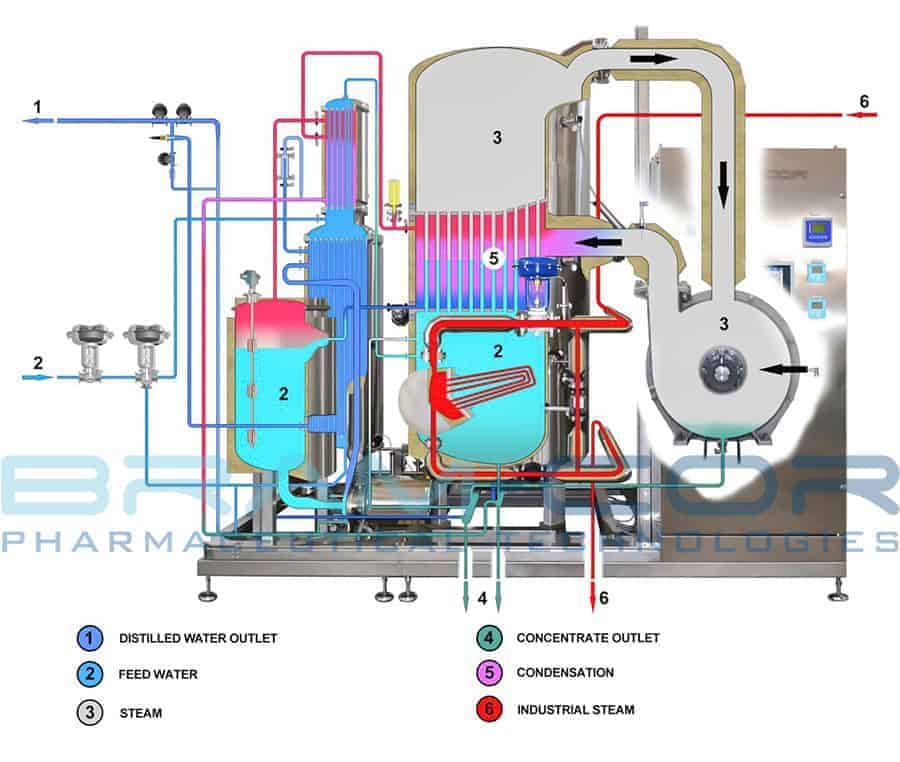
BRAM-COR STMC – Vapor Compression Distiller – function chart
The design, construction and documentation of the STMC distiller is in strict compliance with GMP and FDA regulations, ensuring an easy certification by the relevant authorities.
In detail:
- The Distiller is made of certified AISI 316L stainless steel
- Any internal part in contact with the infeed water, the Pure Steam and the Distillate is mirror-polished
- All hydraulic connections are sanitary tri-clamp or flange connection
- Any gasket is made in PTFE / EPDM
- All weldings are T.I.G
- Vapor is compressed by a special blower.
The recognized benefit of the Vapor Compression technology
- Low energy consumption
- No need for cooling water to condensate the pure steam
- No need for high quality inlet water (in some cases even softened water can feed the VC still)
- Very high quality WFI due to strong degassing process
- No need to pressurize the inlet water
- WFI outflow at high pressure (1 – 1.5 bar) without any additional pump
- Extremely safe process, with no risk of any cross contamination through plant steam or inlet water
- Highest flexibility in terms of capacities and WFI temperatures
- Reduced Maintenance
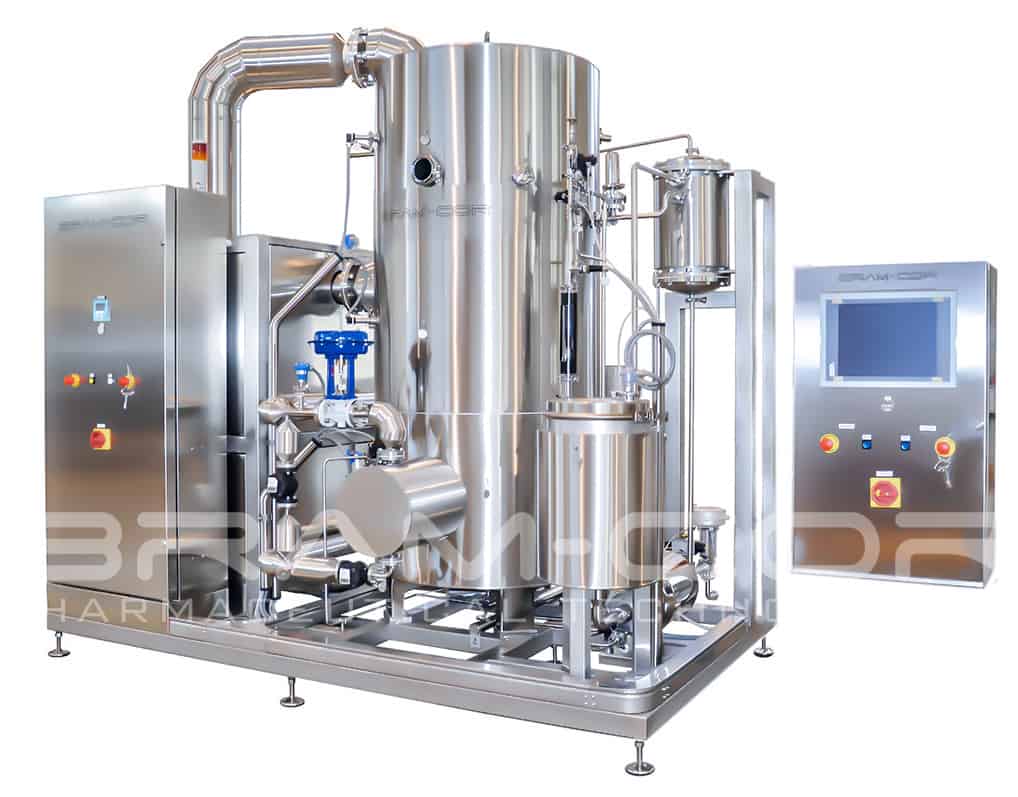 Producing WFI: STMC Vapor Compression system with remote SCADA system
Producing WFI: STMC Vapor Compression system with remote SCADA system
Note about evaporation
A vertically-mounted compressor will evaporate water on either a falling film or thin rising film principle for drier steam, whereas spray film units direct water over the horizontal surface area of the evaporation tubes for a more wetted surface. Since the separation of impurities from the steam is done by more of mechanical process (vs. multi-effect’s centrifugal action) a secondary separation system is in place. Commonly, a demister pad is used but a newer approach utilizes a baffle similar to those found in multiple-effect stills for a design which is considered more sterile as it is fully drainable. Therefore, a full automation ensures easy operation and total monitoring of critical parameters, by means of certified in-line instruments and of a careful alarm policy. Access policy and records can be managed according to 21 CFR PART 11.
Note about blower
A further enhancement of VCD has been the BRAM-COR multistage blower compressor which runs under 4000 rpm, significantly reducing operating noise level (below 65-70 dB) and maintenance. A standardized approach to mechanical seal design can also reduce the maintenance time typically associated with their changeover as well as prevent or minimize leakage over a longer operating period. The issue of non-condensable gas removal is as standard addressed by vapor compression designs by preceding the compressor with a deaerator.
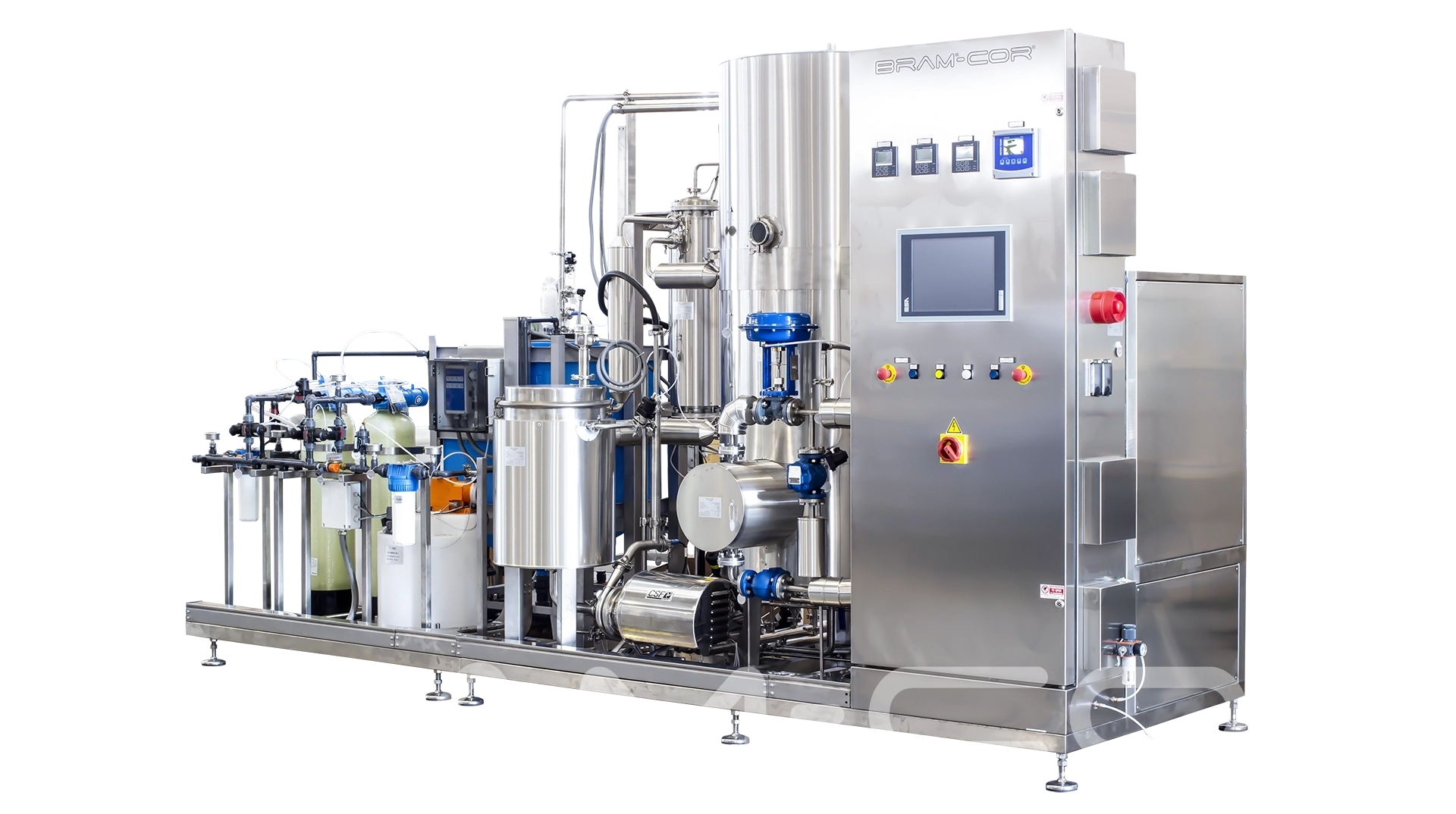
More on: Vapor Compression Distiller Operating system in this site
See also Bram-Cor STMC reference website: vapor-compression-distiller.com
Water for Injection systems by Multiple Effect Distillation
The advantage of less moving parts
BRAM-COR Multi Effect Stills Mod. SMPT are designed and manufactured according to cGMP to produce compendial Water for Injection. Each unit contains a number of boiling columns (or effects) with the first column producing pure steam, which is condensed and re-distilled in subsequent columns to reduce operating costs. Heating for evaporation and cooling for condensation processes are performed by double tube sheet (DTS) exchangers. Condensation is achieved using thin-film technology. The process is repeated in each column: the higher the quantity of columns the lower overall the consumption of the unit. The number of columns therefore has no effect on the quality or performance of the system.
Note about preheaters and evaporators
Preheaters will make the Multiple Effect still operate more efficiently in regards to steam and water consumption, but are not always a standard feature. A preheater can be installed prior to the first column for additional benefit, or prior to all columns for maximum benefit. Evaporators will be located internal or external to the column.
The evaporators bear the brunt of varying pressures and temperatures. If there is any severe failure to the still, it will most likely be with the evaporator. For this reason, the first evaporator should have a double-tube sheet design; it should be decided in the specification process if all evaporators should be of double tube-sheet design since this is not a standard with all manufacturers.
The quality of Bram-Cor construction
A special labyrinth-separator installed at the top of each column separates the steam generated by the evaporation process from entrained substance in the steam itself. The result is a pure, “dry”, pyrogen-free steam, condensed in compendial Water for Injection. The first column of the Still may be used to produce also Clean Steam alternatively or even at same time. Pressure vessels are designed according to ASME and PED regulation and the equipment features:
- Double tube sheet heath exchangers
- Certified AISI 316L stainless steel mirror-polished and passivated product contact surfaces
- AISI 304 frame, jackets and control board
- PTFE gaskets
- Pneumatic valves with Teflon membranes and AISI 316 L SS polished body
- ASTM C-795 – compliant insulation.
Capacities range: from 50 to 15.000 lph with three to ten columns.
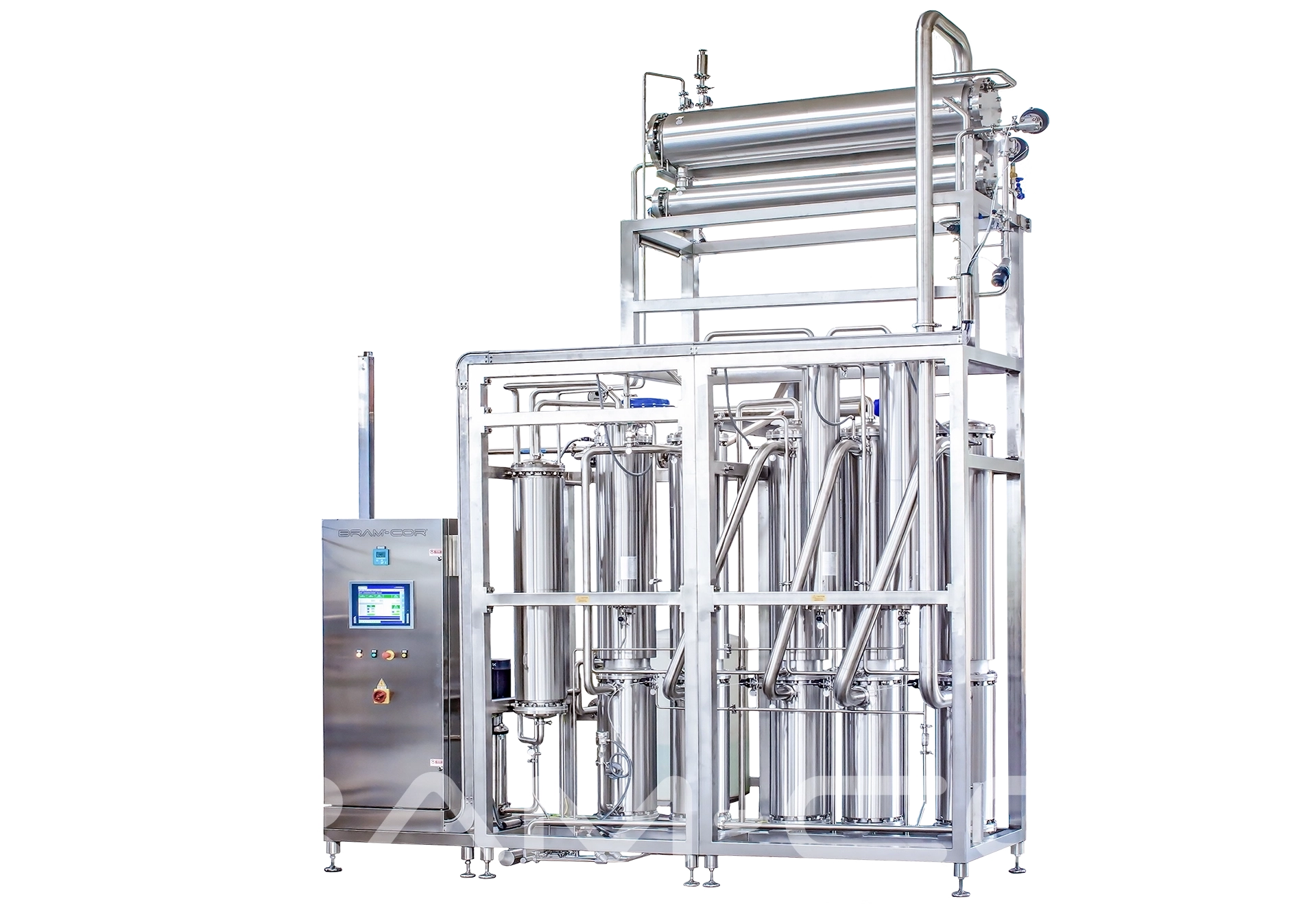
More on: Multiple Effect Distiller Operating system in this site
See also Bram-Cor SMPT reference website: www.multiple-effect-water-distiller.com
Water for Injection production from Single Effect Distillation
The advantage: both a Still and a Pure Steam Generator
BRAM-COR Single Effect Distiller Mod. DPSG is both a Still and a Pure Steam Generator. The production process consists in PW water evaporation followed by pure steam separation and condensation. The steam is purified using centrifugal and gravity separation methods. This equipment produces dry, saturated steam to be used as sterilizing agent.
Naturally, the Pure Steam, when condensed through a Double Tube Sheet condenser, meets the requirements of international pharmacopoeias for Water for Injection. The system can therefore provide a simultaneous production of Pure Steam and Water for Injection.
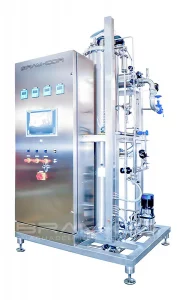
Note about Pure Steam Generator
BRAM-COR CPSG, Pure Steam Generator, produces dry and saturated steam: this steam, when condensed, meets USP requirements for Water for Injection (WFI) (see the relevant page on this site).
See also the Bram-Cor CPSG reference website pure-steam-generator.com
